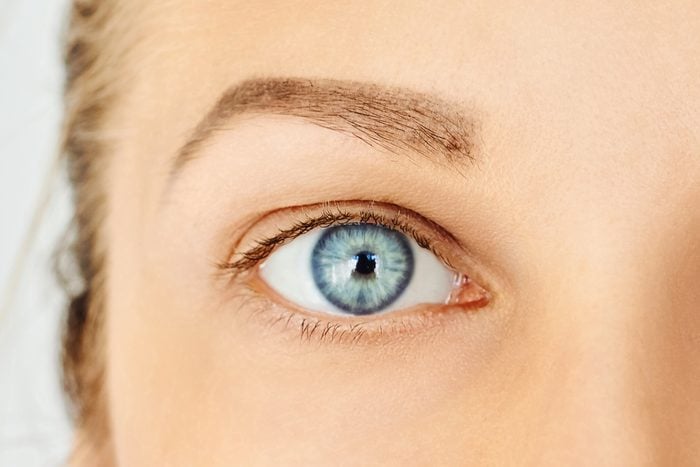13 Fascinating Scientific Facts About Blue Eyes
Updated: Apr. 23, 2024

Do you have blue eyes? We talked to experts to discover curious facts about baby blues, including whether your biological family is bigger than you ever imagined.
Like most human traits, blue eyes are determined by genes, and no two people have exactly the same hue. It works a lot like individual fingerprints, making our eyes two of the most distinctive parts of us.
The color of your eyes is really the color of your iris, the ring that surrounds the black pupil in the middle of your eye. Unlike some other inherited traits (like the color of your hair), eye color typically doesn’t change naturally throughout your life. Sure, it can appear to vary depending on the external light source, but the pigment shouldn’t fluctuate (if your eyes do seem to change color, see a specialist).
But your eyes aren’t just a pretty feature of your face. They can provide surprising insight into your personality, health status and where you came from in the big story of human history. We talked to three experts—doctors and researchers with a deep understanding of eyes and human health—to find out all about blue eyes, including whether everyone with blue eyes is related and some weird facts about the human body. Keep reading for everything you ever wanted to know about those baby blues.
Get Reader’s Digest’s Read Up newsletter for more fascinating facts, humor, cleaning, travel and tech all week long.
What determines eye color?
The color of your eye is determined largely by the interaction of several genes, chief among them the OCA2 gene. The HERC2 gene is another that plays an outsize role in determining eye color.
Together, all these genes regulate the pigment called melanin. “It’s that pigment that defines the color of the eyes,” says Jay Chhablani, MD, professor of ophthalmology at the University of Pittsburgh. “Higher melanin levels lead to darker pupils. Lower melanin levels lead to light or blue eyes.”
Of course, not all blue eyes are the same. The gradations in blue are due to variations in melanin levels as well. Melanin also helps determine the color of your hair and your skin. The more melanin you have in your skin or hair, the darker they appear. And if your genes have given you both blue eyes and red hair? Well, you’re rocking the rarest hair color and eye color combination in humans.
Are all blue-eyed people related?
Yes, all blue-eyed people have a common ancestor. Through a genetic analysis of blue-eyed people in Jordan, Denmark and Turkey, among other areas, researchers managed to trace this trait to a single genetic mutation in one individual that occurred between 6,000 and 10,000 years ago. According to the researchers, who published their findings in the journal Human Genetics, the mutation is on the OCA2 gene, which regulates melanin production. Specifically, the mutation decreases the amount of melanin.
Before the appearance of the mutation, the authors state, all humans shared brown eyes, which is the natural color of melanin.
Facts about blue eyes
Having a common ancestor is just one quirky fact about blue eyes. We talked to three experts to find out other reasons blue eyes are special.
Blue is not the rarest eye color
In fact, it’s the second most common in the United States after brown eyes. According to the American Academy of Ophthalmology, about 27% of Americans have blue eyes, while 45% have brown eyes. Across the world, 8% to 10% of people have blue eyes, which is still second place to brown eyes, which 70% to 80% of all individuals have.
The rarest eye colors are green and gray. An even smaller proportion of people have different-colored eyes, which is called heterochromia.
Blue-eyed people have a higher risk of melanoma
Having fair skin and light hair increases your risk for melanoma, but so does having blue eyes. In fact, light eyes are a risk factor even if you don’t have red hair and/or fair skin, says Gregory Papadeas, DO, a Denver-based dermatologist and the past president of the Colorado Dermatologic Society. That’s because blue-eyed people have less melanin, which protects against ultraviolet light, he explains.
Blue-eyed people also have a higher risk of uveal (eye) melanoma, a rare cancer that affects about five in every million individuals.
Your blue eyes aren’t actually blue

The color of your iris doesn’t reflect the color of the pigment. Instead, it’s an interplay between the amount of melanin and how it reflects light.
Blue eyes (and other lighter colors that indicate less melanin) absorb less light. Whatever light does get in through your pupil is scattered by collagen fibers, which make the eyes look blue. (Collagen fibers help maintain the structure of the eye.)
By contrast, people with more melanin and darker eyes absorb more light.
Blue-eyed people may feel less pain
Here’s one upside to those baby-blue eyes: Research has indicated that people with light-colored eyes (like blue or green) have a higher tolerance for pain than darker-eyed people. In a pilot study published in the Journal of Pain, women undergoing labor were categorized according to eye color. Those with brown or hazel eyes had more anxiety, greater trouble sleeping and more pain than their light-eyed counterparts. Of course, how we perceive pain is also related to other traits, such as age, gender and hair color.
Blue-eyed people may be more competitive
Looking for someone to challenge you in your latest athletic or academic endeavor? Compete against a buddy with blue eyes.
Researchers who looked at whether eye color and certain personality features were linked found that people of North European descent with lighter eyes were less agreeable, which is just another way of saying “competitive.” The authors of the study, which was published in Current Psychology, pointed to light-eyed individuals, including those with blue eyes, as being more egocentric and skeptical. People with darker eyes, by contrast, are viewed as more sympathetic and altruistic.
Blue-eyed males may have female-shaped faces
Research has shown that baby blues seem to be linked with features typically associated with a female face, such as smaller and sharper chins, narrower mouths, smaller noses and wide-set eyes, says Peter Frost, PhD, an anthropologist who studies the role of sexual selection in shaping visible human traits. Brown eyes were associated with more masculine facial features, such as broader chins and mouths, larger noses and eyebrows, and closer-set eyes.
Some of this may be explained by the fact that non-brown eye colors seem to develop more easily if body tissues have a higher level of estrogen during fetal development, says Frost. “If a male fetus has more estrogen than average, it will more likely develop blue eyes and a more feminine face,” he explains. “This association is absent in women because a female fetus normally has enough estrogen in its body tissues to feminize the face.”
Blue-eyed people have a higher risk of macular degeneration
Strange as it may seem, your eye color can raise your risk of certain ocular diseases. Several studies have pointed to an association between macular degeneration and blue eyes. The macula is the central part of the eye’s retina, which converts images into electrical signals that are then passed on to the brain. When the cells in the macula are damaged, you start to lose your central vision.
“A relationship between macular degeneration and blue eyes is pretty well established,” says Dr. Chhablani. That’s probably because blue eyes allow more light to enter the eye, and that light, in turn, can damage the eye, he explains.
Blue-eyed people have fewer cataracts
On the plus side, blue-eyed people may have a lower risk of cataracts, which is when the lens of your eye (right behind the iris) becomes cloudy and compromises vision, says Dr. Chhablani. An American Journal of Ophthalmology study of 3,654 Australians with dark- and light-colored eyes found a much higher risk of cataracts in participants with dark eyes.
The greatest risk factor for cataracts, though, is age. The National Eye Institute reports that more than half of Americans ages 80 and above have or have had cataracts.
Blue-eyed people are less likely to have vitiligo
Another positive? Having blue eyes may also mean that you have a lower risk of vitiligo, which is when patches of skin become lighter. Researchers speculate that the genes for blue eyes and for vitiligo may be connected.
Blue-eyed people are more sensitive to light
The technical term is “photophobia,” and yes, people with blue, green or gray eyes, do seem to be more sensitive to both sunlight and even fluorescent lights. Again, it boils down to the amount of pigmentation in your eyes. Less pigmentation means less defense against bright light.
That said, it’s a good idea for all of us, regardless of skin, hair or eye color, to stay out of the sun and to protect our eyes when we’re outside, especially during the middle of the day.
Blue-eyed people may drink more alcohol
Research suggests that blue-eyed people not only drink more alcohol but may be more likely to be alcohol dependent too. In a study published in the American Journal of Medical Genetics, participants with blue eyes had an 83% higher risk of being alcohol dependent compared with brown-eyed folks. Subsequent genetic analysis showed a number of interactions between genes governing eye color and those governing alcohol dependence.
About the experts
- Jay Chhablani, MD, is a professor of ophthalmology and a vitreoretinal surgeon in the Department of Ophthalmology at the University of Pittsburgh. He has published more than 580 articles in peer-reviewed journals and is the editor of three books on eye disorders.
- Gregory Papadeas, DO, is a dermatologist in private practice in Denver. He is a fellow of the American Academy of Dermatology and past president of the Colorado Dermatologic Society as well as the American Osteopathic College of Dermatology.
- Peter Frost received a PhD in anthropology from Université Laval in 1995. His main research interest has been the role of sexual selection in shaping visible human traits, especially skin color, hair color and eye color. He is now semi-retired but still works as a translator/copy editor for an anthropology journal and for researchers who work with northern native peoples.
Sources:
- Human Genetics: “Blue eye color in humans may be caused by a perfectly associated founder mutation in a regulatory element located within the HERC2 gene inhibiting OCA2 expression”
- Scientific Reports: “Genetic markers of pigmentation are novel risk loci for uveal melanoma”
- International Journal of Molecular Sciences: “Iris Colour and the Risk of Developing Uveal Melanoma”
- Clinical Ophthalmology: “Uveal melanoma: epidemiology, etiology, and treatment of primary disease”
- The Journal of Pain: “Correlation between eye color and pain phenotypes in healthy women”
- Current Psychology: “Eye color predicts Disagreeableness in North Europeans: Support in Favor of Frost”
- Personality and Individual Differences: “Eye color predicts but does not directly influence perceived dominance in men”
- Investigative Ophthalmology & Visual Science: “Retinal Vascular Caliber, Iris Color, and Age-Related Macular Degeneration in the Irish Nun Eye Study”
- Clinical and Experimental Ophthalmology: “Iris colour, ethnic origin and progression of age-related macular degeneration”
- American Journal of Ophthalmology: “Iris color and cataract: the Blue Mountains Eye Study”
- American Journal of Medical Genetics: “Eye color: A potential indicator of alcohol dependence risk in European Americans”



